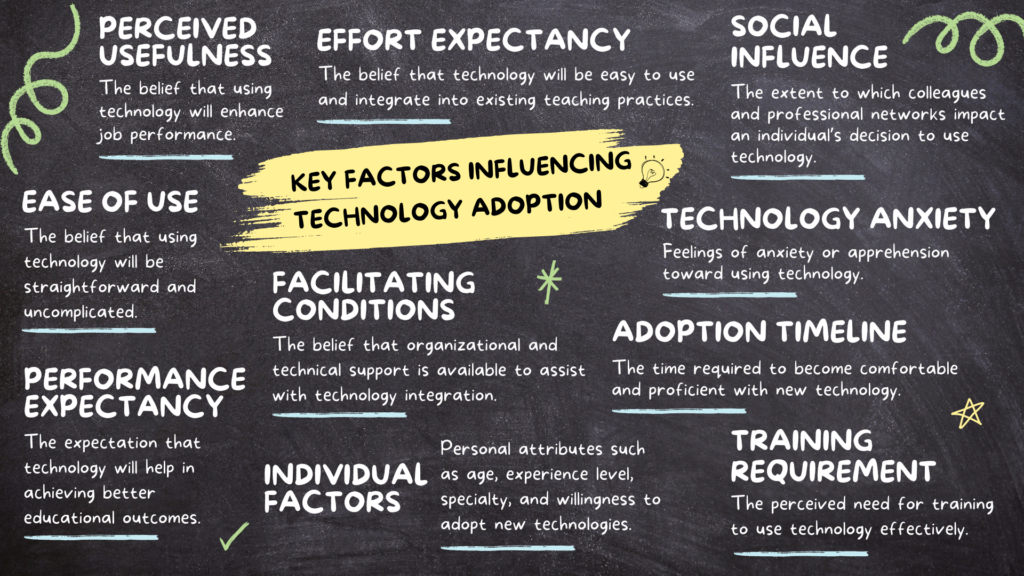The Science of Technology Acceptance: Decoding Educators’ Engagement


 Effective adoption of technology in classrooms depends significantly on educators’ willingness to use it. When educators embrace technology, it leads to more effective integration and enhanced student performance and engagement.
Effective adoption of technology in classrooms depends significantly on educators’ willingness to use it. When educators embrace technology, it leads to more effective integration and enhanced student performance and engagement.

Many factors influence educators’ decisions to adopt technology, including:
Perceived Usefulness: The belief that using technology will enhance job performance.
Example: A teacher finds a particular educational app helps her save time when preparing differentiated lesson plans for her group.
Perceived Ease of Use: The belief that using technology will be straightforward and uncomplicated.
Example: User-friendly software allows teachers with minimal tech skills to create interactive lessons.
Performance Expectancy: The expectation that technology will help in achieving better educational outcomes.
Example: A teacher anticipates that a digital storytelling app will enhance students’ verbal skills.
Effort Expectancy: The belief that technology will be easy to use and integrate into existing teaching practices.
Example: A tool that easily integrates into the current stack of apps used by children allows teachers to track students’ progress efficiently and effortlessly.
Social Influence: The extent to which colleagues and professional networks impact an individual’s decision to use technology.
Example: A teacher decides to use a specific learning management system because it comes highly recommended by peers.
Facilitating Conditions: The belief that organizational and technical support is available to assist with technology integration.
Example: A teacher’s school is in full support of the new technology integration and is providing varying amounts of support as needed to all teachers.
Individual Factors: Personal attributes such as age, experience level, specialty, and willingness to adopt new technologies.
Example: A teacher’s individual preferences and comfort with technology influence their adoption of new tools, irrespective of their tenure in the profession.
Technology Anxiety: Feelings of anxiety or apprehension toward using technology.
Example: A teacher who has faced challenges with technology in the past might feel cautious about trying new tools but is open to doing so with the right support.
Adoption Timeline: The time required to become comfortable and proficient with new technology.
Example: A teacher may need a period of training and practice to effectively integrate an interactive whiteboard into their teaching routine.
Training Requirement: The perceived need for training to use technology effectively.
Example: A teacher believes that proper training is crucial for using a digital assessment tool effectively, ensuring they can evaluate students’ developmental progress accurately.
The journey to comprehensive technology integration in education is not without its challenges. Recognizing and addressing these barriers is a crucial step toward fostering a positive environment for digital adoption.
Scarcity of adequately trained personnel can significantly impede the implementation and maintenance of technological tools in educational settings. When the staff-to-technology ratio is imbalanced and technical support is insufficient, educators be reluctant to adopt new digital tools.
Reliability is key for technology to be effective in educational use. Frequent glitches or malfunctions can disrupt the teaching process, leading to frustration and a potential rejection of digital tools. A single glitch can often have a lasting impact on a teacher’s perception of the tool.
Tight schedules are the norm for educators. Thus, finding the time to learn and integrate new technologies can be a significant challenge. The allure of sticking with familiar, traditional teaching methods becomes stronger when time is of the essence, particularly when immediate educational interventions are required.
Moving beyond external barriers, it is essential to delve into the intrinsic features of the technology itself, evaluating how these characteristics can influence an educator’s decision to adopt or reject digital tools.
Technology must serve a clear and direct purpose in the educational process, enhancing teaching and learning outcomes. Tools that align well with educational objectives and show tangible benefits are more likely to gain acceptance.
The user-friendliness of a tool plays a critical role in its adoption. Technologies with intuitive interfaces and straightforward navigation are more appealing to educators, encouraging integration into classroom activities.
Ensuring that technology is accessible to all, including individuals with disabilities, is a non-negotiable aspect of digital adoption. Tools that cater to a diverse user base promote an inclusive educational environment.
The cost-effectiveness of technology is a significant consideration for educators and educational institutions. Tools that offer substantial benefits at a reasonable cost are more likely to be embraced.
The visual appeal of a technology tool can influence its attractiveness to educators. Engaging and well-designed tools are more likely to capture attention and encourage exploration.
The ability to easily locate and access technology tools is essential for a smooth user experience. Efficient search and navigation features play a pivotal role in this aspect.
Finally, the credibility of the technology, encompassing its reliability, accuracy, and overall trustworthiness, is paramount. Educators need to have confidence in the tools they use, trusting that they will perform consistently and deliver reliable results.
As we navigate the intricacies of technology acceptance in education, it becomes clear that the path to digital integration is multifaceted. Educators play a crucial role in this journey, and their readiness to embrace technology is influenced by a complex interplay of personal beliefs, external influences, and the characteristics of the technology itself.
It is necessary to address barriers to technology acceptance and fostering an environment that values utility, ease of use, accessibility, and trustworthiness in digital tools. By doing so, we pave the way for a future where technology not only enhances the teaching and learning experience but also becomes an integral, seamlessly integrated component of the educational landscape. Through understanding, support, and continuous learning, we can unlock the full potential of technology in education, creating enriching and inclusive learning environments for all.
Childhood Education International (CE International) is dedicated to empowering leaders to catalyze innovation and cultivate positive transformations in their educational ecosystems, always emphasizing the responsible adoption of emerging technologies.
Note: CE International does not endorse any of the products or online learning materials mentioned in this article.